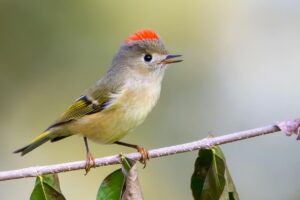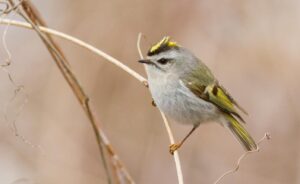On my first day serving with Friends of Mashpee National Wildlife Refuge, as we were gathering signs from our recent “Walk for the Wild” event along Great Hay Road in the Mashpee National Wildlife Refuge, the sound of birdsong caught our attention. I recognized the call right away, a Ruby-Crowned Kinglet. These small, lively birds are often found near water and are known for their vibrant feathers on top of their head. Despite their size, Ruby-Crowned Kinglets have a surprisingly powerful voice, and hearing their song that day added a lovely touch to our walk.

Ruby-Crowned Kinglet
The Ruby-Crowned Kinglet is a small, olive-green bird, with a thin tail. They have relatively large heads with a small, black beak and black wings with a distinctive white wing bar. They are named for the bright red patch of feathers sometimes seen on the top of the head in adult males. This “crown” can be concealed or exposed depending on the needs of the bird. The crest can be hidden under olive feathers when under normal circumstances or shown off when trying to attract a mate, adding a vibrant splash of color to their appearance that can make them easy to spot.
This kinglet species is often a rare sight out on Cape Cod, usually only seen in the fall on their migration south for the winter, although some decide to brave the winter up here in hopes of a mild winter and easier migration to their breeding grounds. They spend the summer months up north in Canada and along the western mountains of the United States, and then Migrate to the southern half of the US and Mexico for the winter, with the mountainous populations often simply moving to lower elevations.
The following week, we returned to the same trail to finish collecting the signs. This time, we became surrounded by birdsong in the middle of the woods, but this time it was a Golden-Crowned Kinglet, who has a slightly different song. Though we didn’t manage to spot either bird, the beautiful song of both birds created an atmosphere of wonder for the two of us, where Lucinda could tell me about the important history of the Great Hay Road, and I could share what I knew about the birds we heard along the way.

Golden-Crowned Kinglet
At first glance, the Golden-Crowned Kinglet looks quite similar to the Ruby-Crowned Kinglet. Both species share a similar size, shape, and olive-green coloring. However, the Golden-Crowned Kinglet has a paler belly and a more striking facial pattern, with bold white markings around the eyes and a golden crest surrounded by black stripes. Unlike the Ruby-Crowned Kinglet, both male and female Golden-Crowned Kinglets have a yellow stripe on their heads that cannot be fully concealed. However, males can make their orange-yellow feathers more prominent by raising them during displays.
The Golden-Crowned Kinglet does have a small year-round population on the cape but is also most often seen in fall during their migration. This species has a much narrower range than the other kinglet, staying in the continental United States for the winter and breeding only in the south of Canada, with small year-round populations around the northern East and West US mountain ranges.
Both Kinglets are among North America’s smallest birds, weighing only a few grams more than a hummingbird. If you would like to hear or perhaps even see a kinglet yourself, fall would be the best time to try and do so. Both species like to flit along the canopy in treetops, so it’s often much easier to hear them than to see them. However, once you hear them, all it takes is some patience and a keen eye to catch a glimpse at these gorgeous birds. Kinglets can also be attracted to bird feeders in your very own backyard. They may prefer suet products, mealworms, sunflower chips and peanut pieces.
Experiences like these remind us of the incredible diversity of wildlife in our local refuge and the small joys of spending time outdoors. Whether using apps like Merlin to decipher birdsong or a field guide to identify birds along the trail, birdwatching can be both fulfilling and fun. These moments connect us to nature and highlight the simple pleasures of exploring the world around us. They also underscore the importance of protecting these habitats so that future generations can experience the same sense of wonder that we felt on those trails. Every walk through the refuge offers a new story, a new discovery, and a renewed sense of connection to the environment.
(Article written by Kaycee Doherty, 2024-25 AmeriCorps Member.)
References:
“Golden-crowned kinglet overview”, Cornell Lab of Ornithology. 2019. All About Birds. Cornell Lab of Ornithology, Ithaca, New York. https://www.allaboutbirds.org
“Ruby-crowned kinglet overview”, Cornell Lab of Ornithology. 2019. All About Birds. Cornell Lab of Ornithology, Ithaca, New York. https://www.allaboutbirds.org
Image credits:
[Photo of Ruby-Crowned Kinglet]. (n.d.) [Canva.com]
[Photo of Golden-Crowned Kinglet]. (n.d.) [Canva.com]
